If you’re looking for a tropical houseplant that produces deep green, almost black, foliage lined in hues of vibrant hot pink, look no further than the Calathea Dottie.
This compact plant is a great choice for anyone that has limited space in their indoor garden, and will quickly become a talking point with its contrasting-colored leaves.
Before you can begin your venture into the wonderful world of Calathea, learn what is needed to properly care for this plant.

Table of Contents
How do you care for Calathea Dottie?
The best thing you can do for your Calathea Dottie is to read up on this plant’s growing requirements. Without knowing this basic information, you won’t be able to keep your Calathea happy and healthy, and could even kill the plant.
1. Grow the Calathea Dottie in peat and perlite soil mixture
When deciding which potting mixture to use for the Calathea Dottie, select one that contains perlite or pumas, coir, and potting soil. These ingredients create a well-draining growing medium that can still hold a bit of moisture, but not so much that it keeps the plant’s roots soggy.
Best soil for Calathea
Miracle-Gro Tropical Potting Mix
Light and well-draining (perfect for avoiding root rot) while being packed with just the right nutrients – that will feed your plant for up to six months. The best soil for keeping your calathea healthy and strong.
A good soil recipe for Calathea Dottie is 30-percent potting soil, 30-percent coir, and 30-percent pumas or perlite.
Avoid using soil that is too heavy and compact as this restricts drainage. Additionally, you shouldn’t use a growing medium for succulents, since these types of soils drain too quickly.
2. Give Calathea Dottie bright, indirect sunlight
Like other Calathea plants, the Dottie needs plenty of bright, diffused light for at least 8 to 10 hours every day.
Despite loving the sun, this plant cannot tolerate direct light as it is too harsh for the Calathea Dottie and will quickly lead to leaf burn. In fact, subjecting this plant to direct light can cause its vibrant leaf color to fade.
You may also be interested in: Calathea Light Requirements: The Ultimate Guide
3. Hydrate the plant about once a week during the spring and summer
Calathea Dottie loves soil that stays a bit moist, but it is also prone to overwatering. Because of this, it’s best to let the soil dry out just a little between waterings.
On average, expect to water the plant about once every 7 to 10 days during the spring and summer when the Calathea Dottie is actively growing.
The amount of watering needed during the winter when the plant isn’t actively growing is usually reduced to once or twice a month. You can help prevent overwatering and underwatering by watering the calathea plant only when the top inch or two of soil is dry.
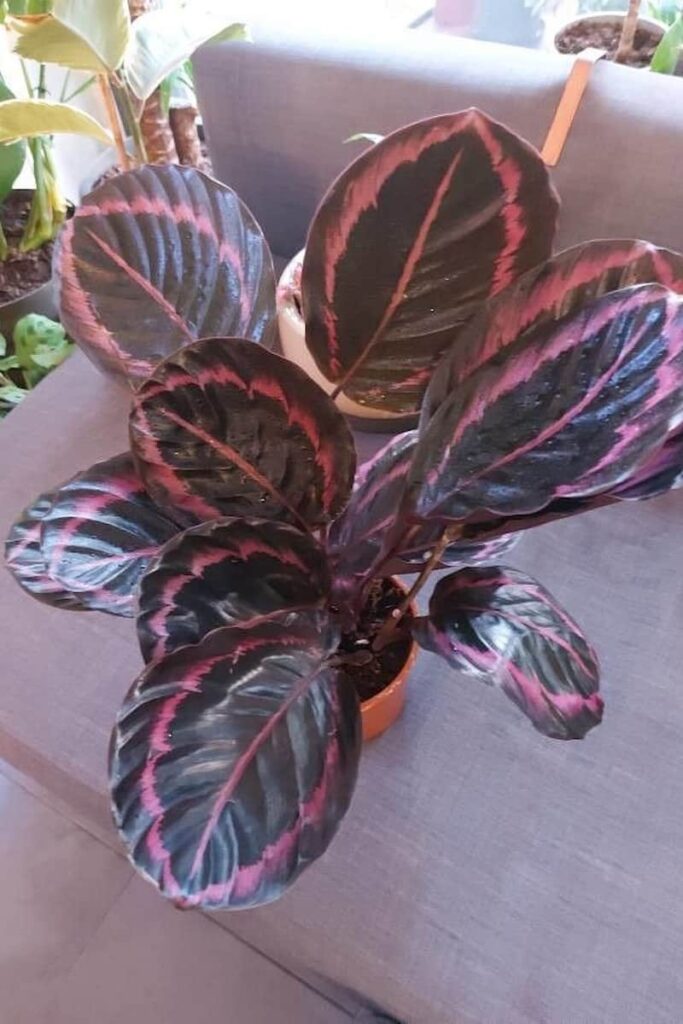
4. Maintain warm temperatures throughout the entire year
The room where you are growing your Calathea Dottie will need to stay warm throughout the entire year. Temperatures should be kept between 65 and 75 degrees.
While the plant won’t have any issues if you expose it to temperatures a little above or below this range for a short period of time, long-term exposure could seriously harm the Calathea Dottie.
5. Calathea Dottie needs high levels of humidity
If you want to ensure your Calathea Dottie is healthy, you will need to meet its high humidity needs.
Most homes maintain a humidity level of around 40-percent, which is well below this plant’s requirements, which is above 60-percent. A humidifier is a quick way to keep the humidity level high.
Other options to increase humidity include setting the Calathea Dottie on a drip tray or misting the plant’s leaves.
Even when the humidity levels are high, you may still need to mist the plant when the conditions are drier than normal. This typically occurs during the winter when the use of heaters is more prevalent.
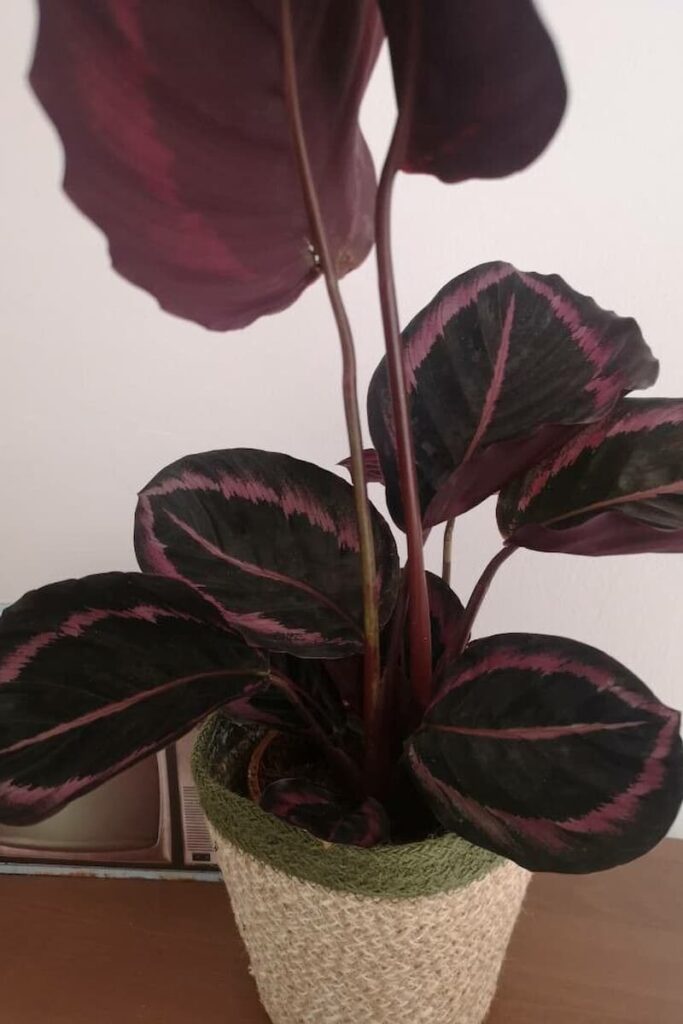
6. Apply a diluted fertilizer once every 2 to 4 weeks during its active growing season
Even though the Calathea Dottie isn’t an overly heavy feeder, this plant will still need to be fertilized about once or twice a month during the spring and summer months. Use a balanced liquid fertilizer designed for tropical houseplants, such as one with an NPK ratio of 5-5-5.
Best fertilizer for Calatheas
Jack’s Classic 20-20-20 All Purpose Fertilizer
A great fertilizer with the perfect balance for your calathea. Simply dissolve in water and feed your plant to watch it thrive.
Before applying your Calathea’s fertilizer, thoroughly water the Calathea and dilute the fertilizer to about 1/2 of its strength.
Not watering the Calathea Dottie before feeding can burn its roots. Additionally, all feeding needs to be stopped in the fall and winter.
This is because the plant isn’t actively growing, and feeding it during this time can interfere with Calathea’s natural growing period.
7. Freshen soil once every year or every two years as needed
Repotting the Calathea Dottie is typically done to freshen the plant’s soil once every year to once every two years. Since this plant doesn’t get too big, you usually won’t have to repot the Calathea Dottie because it has outgrown its container.
That’s not to say it cannot happen, it’s just not as often as needed to refresh the growing medium.
The best time to repot the Calathea Dottie is during the spring or early summer, which is when this plant is actively growing.
This means that it can withstand the natural shock that occurs during the repotting process better than a plant that isn’t actively growing. Additionally, the plant needs to be thoroughly watered a few days before you repot it.
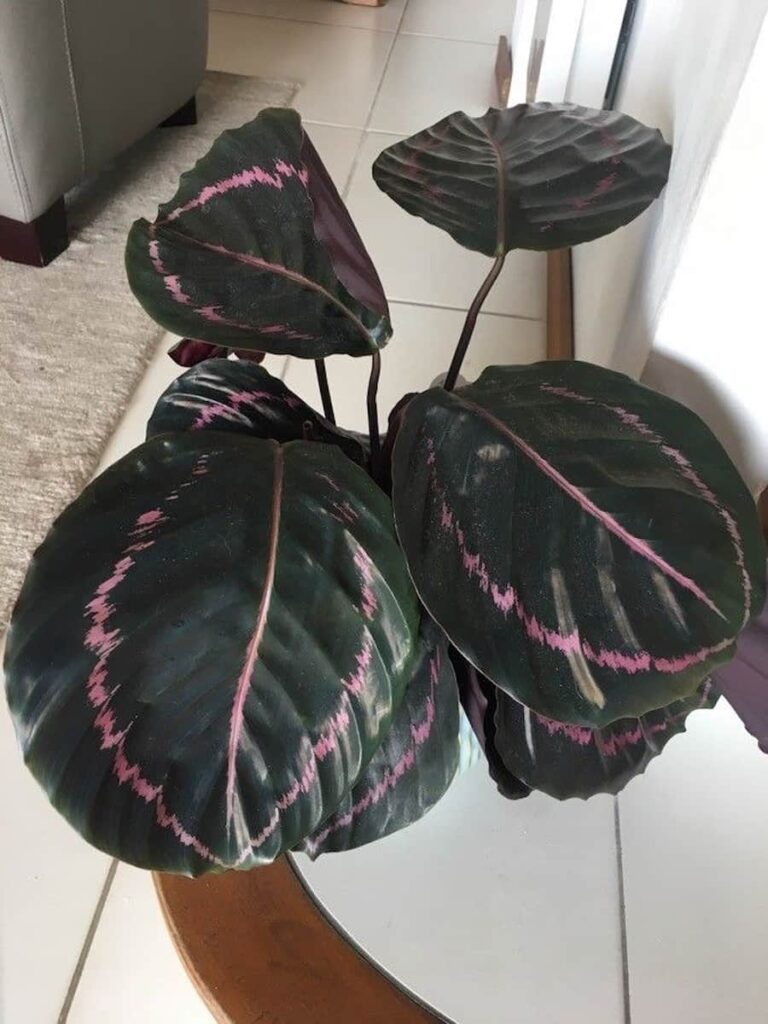
8. Calathea Dottie uses the division method to propagate
While the Calathea Dottie can be propagated, it does require using the division method. This plant cannot propagate via stem or leaf cutting.
The division method is a little more difficult than a simple stem or leaf cutting, but the chances of success with this method is higher than other methods.
This is because the Calathea Dottie produces offshoots or baby Calatheas at the base of its stem. These baby plants have their own root system. That means you don’t need to wait for the cutting to root as you would with the stem or leaf cutting.
With that said, however, you will need to tip Calathea Dottie’s pot to its side and carefully slide the plant out of its container. Locate the baby Calatheas, separate their root system from the parent plant’s root system, and then plant the young Calathea Dottie in its own container.
Related: 10 Easy Steps to Propagate Calathea Plants
9. Water the Calathea Dottie with distilled water
While tap water doesn’t always cause problems for houseplants, it can quickly cause a build up of minerals, salts, and other additives in Calathea’s soil.
These additives act in a similar manner as over fertilizing the plant and can burn and damage Calathea Dottie’s roots. Distilled water, however, doesn’t have these additional items added and can be safely used to water plants.
Filtered water and even rain water can also be used, but may not be as “clean” as distilled water. If your only choice is tap water, make sure to let the water sit in the watering jug overnight before using it to water the plants.
This will give the chlorine inside the water a chance to dissipate, which means one less potentially harmful additive gets introduced to your Calathea Dottie.

10. Mist the Calathea Dottie‘s leaves during periods of dry conditions
Calathea Dottie is susceptible to dry air, and it can cause its leaves to become brittle, curl, and even turn brown. If the plant continues to be exposed to dry air, the overall growth and health of Calathea Dottie will suffer.
Misting the plant’s leaves whenever conditions are dry is a great way to prevent this from occurring, while also keeping its delicate leaves hydrated.
Just make sure you are using distilled water when misting the leaves, since the Calathea Dottie is sensitive to tap water. Additionally, care must be taken not to overmist the Calathea Dottie as this can lead to fungal diseases.
If you are misting the plant so much that the soil is becoming soil, immediately stop misting and watering the Calathea and let the soil dry out before hydrating the plant again.
11. Pruning isn’t needed unless you want to clean up dead or dying leaves
Calathea Dottie doesn’t require regular pruning, but you can snip off the dead or dying leaves to improve the appearance of the plant. Removing these leaves also frees up valuable resources and makes room for new growth to emerge.
In most cases, however, you won’t need to prune this plant to control its growth, since the plant has a rather compact form.

Any leaves removed from the Calathea Dottie should be discarded in the trash or placed in a compact pile.
Furthermore, only use sharp and clean pruning shears when pruning the plant, and always properly clean and sanitize the cutting tools after every use. This helps to prevent the potential spread of diseases and pests like spider mites on calathea.
Are Calathea Dottie rare?
The Calathea Dottie isn’t the rarest Calathea variety out there, but it isn’t nearly as readily available as some of the other cultivars. This does mean that trying to find this plant to purchase can be a bit more difficult, and the price range for the Calathea Dottie is usually higher than more popular varieties.
What’s a standard Calathea Dottie price?
The standard Calathea Dottie price varies depending on the size of the plant you are purchasing. Starter plants typically cost about $15, while a Calathea Dottie in a 4-inch pot can cost over $20.
If you want a larger, more established Calathea Dottie, expect to pay close to $100 or more for one in an 8-inch pot.

Are Calathea Dottie hard to care for?
While Calatheas are known to be a bit temperamental, that doesn’t mean they are hard to care for. They do, however, require specific growing conditions that will need to be met if you want to have success with this houseplant.
Unlike some other common houseplants, the Calathea Dottie cannot tolerate a slew of different conditions and trying to force this plant to live how you want it will only lead to its demise.
Once you know what this plant needs, however, you will find that it isn’t harder to care for than any other tropical plant.
How big do Calathea Dottie get?
The Calathea Dottie can reach heights of 6 to 15 inches tall and wide when grown indoors as a houseplant. In its native habitat, the Calathea Dottie has been known to grow as big as 30 or more inches tall.
But to be fair, don’t expect it to get this tall as it generally stays more compact when grown inside.
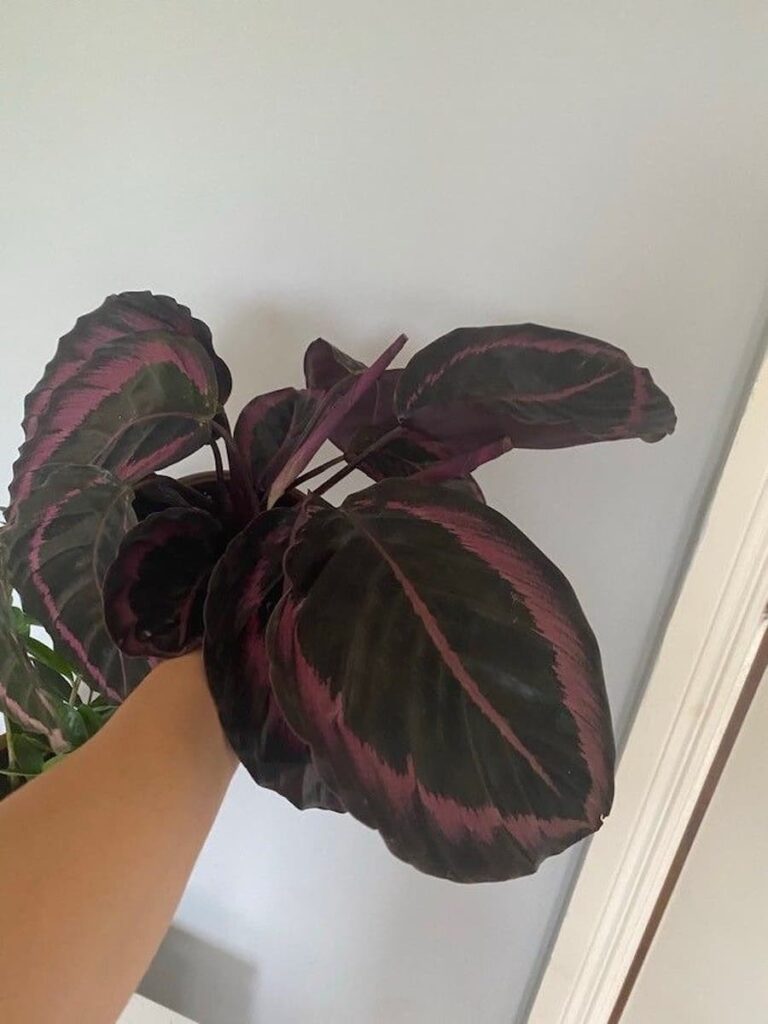
Are Calathea Dottie really pink?
Calathea Dottie has leaves that are deep green, looking almost black, lined with bright pink. The underside of each leaf is pale to dark pink in color, which is put on display whenever the Calathea Dottie closes its leaves at night.
The contrast of the dark leaves with the hot pink trim is just one of the things that makes the Calathea Dottie such a stunning addition to your indoor garden!
Where should I keep my Calathea Dottie?
The Calathea Dottie needs a sunny room where it can receive 8 to10 hours of indirect or diffused sunlight. Artificial lighting can be used if the natural sunlight is lacking, but it will need to be indirect as well.
Allowing the Calathea Dottie to grow in direct light will cause its vibrant foliage to fade and could even burn or scorch its leaves.
Whatever area you choose, the temperatures need to be mild and warm, falling between 65 and 75 degrees. Avoid any area where the temperatures drastically fluctuate, such as near heating and cooling vents.
Drafty windows and exterior doors can all cause the temperature in a room to rise and fall too drastically for this plant.
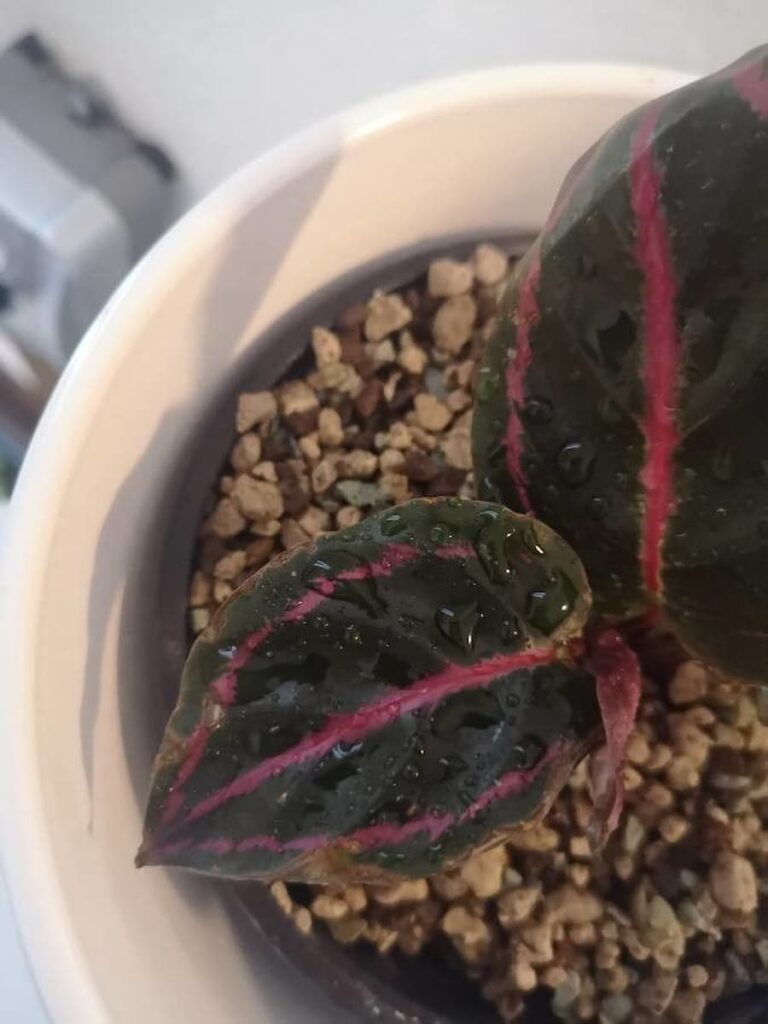
Common Calathea Dottie problems
Calathea Dottie doesn’t have a lot of problems, but this plant is susceptible to overwatering. This typically occurs because the Calathea Dottie likes to have its soil stay moist.
Letting the soil dry out a little between each watering, and only watering the plant when the top inch or two of soil becomes dry goes a long way to preventing overwatering.
Another potential problem of the Calathea Dottie is leaf damage caused by tap water. Not all plants are negatively impacted by tap water, but the Calathea Dottie is. The good news is that this is completely preventable by merely using distilled water instead of tap water to hydrate the plant.
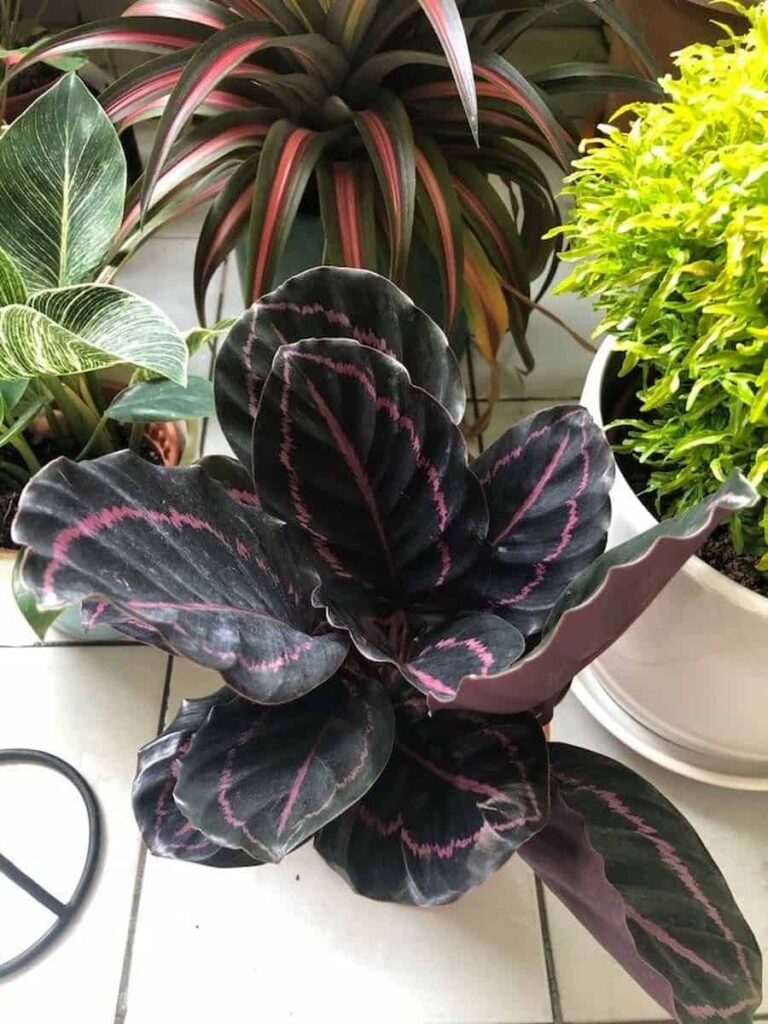
Dry conditions can also become a Calathea Dottie problem, especially if you are neglecting the plant’s watering needs while also growing the plant in dry conditions.
Watering the Calathea Dottie about once a week during the spring and summer while also maintaining a humidity level of at least 60-percent will ensure this problem doesn’t happen.
Why are the leaves of my Calathea Dottie curling?
There are a few things that can cause the Calathea Dottie leaves to curl, including too little water, low levels of humidity, overfeeding, and tap water. The first thing to check is to ensure the soil isn’t completely dried out.
If so, water the plant deeply and you should see the leaves uncurl in a matter of days.
Correct low levels of humidity by turning on a humidifier or misting the Calathea Dottie’s leaves. Both of these options will add moisture to the air and help keep the plant’s leaves supple.
If you are using tap water to hydrate the Calathea Dottie, switch to distilled water instead. Tap water contains various additives, such as excess salts, chlorine, and minerals, that can build up in Calathea Dottie’s soil and burn the plant.
Fortunately, there’s an easy fix, as using distilled water instead helps to prevent this from occurring.
Find out more about: 6 Causes of Your Calathea Leaves Curling (+ How to Fix It)
Why are my Calathea Dottie’s leaves turning brown?
Calathea Dottie leaves turning brown are a sign that the plant isn’t getting the right amount of humidity. When the humidity levels are not 60-percent or above, the air becomes too dry for the tropical Calathea and its leaves start to dry out, become brittle, and turn brown.
This is because low humidity levels prevent the Calathea Dottie from absorbing enough water.
Thankfully, you can prevent this leaves turning brown from occurring by using a humidifier, drip tray, or misting the plant’s leaves. In most cases, you will need to use a combination of those three methods to ensure that Calathea Dottie is receiving the right amount of humidity.
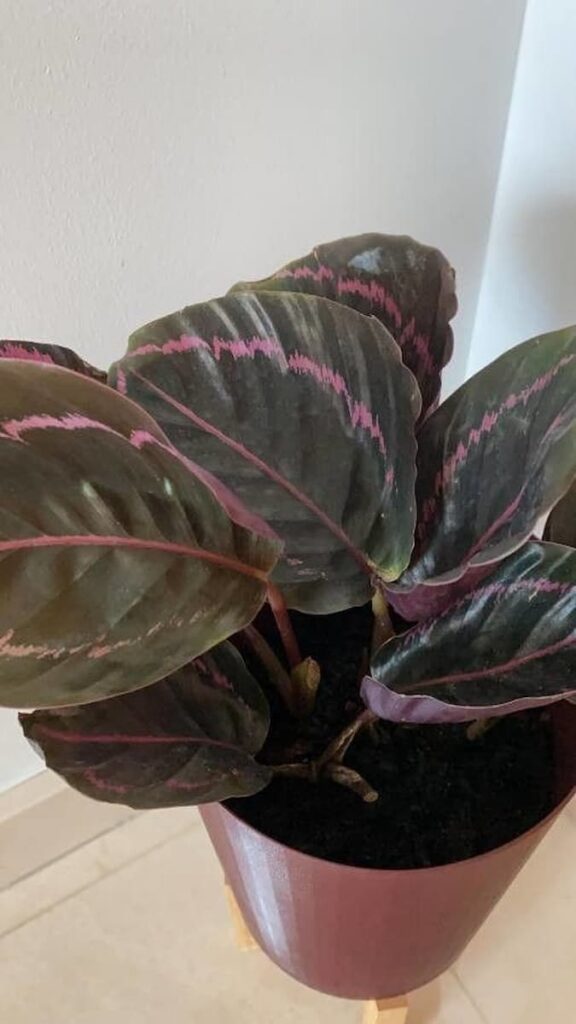
Why are my Calathea Dottie’s leaves turning yellow?
Yellowing leaves are most often the result of overwatering your Calathea Dottie. While this plant does like moist soil, it can quickly become damaged when you over hydrate it. If the overwatering continues, the Calathea Dottie will develop root rot and the plant could die in a matter of days.
When you have overwatered the Calathea Dottie, immediately cease all watering and let the soil dry out before giving the plant something to drink. If the overwatering has continued for an extended period of time, the plant will have to be repotted in fresh soil.
This requires removing the plant from its original container, getting rid of all the soil it is currently growing in, cleaning and sanitizing the pot, and then planting the Calathea Dottie back into the container with fresh, dry soil.


